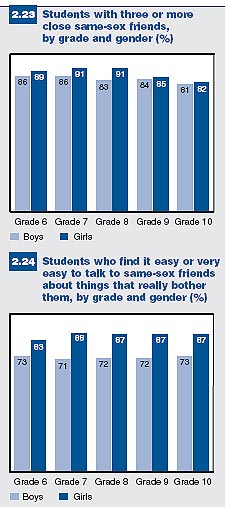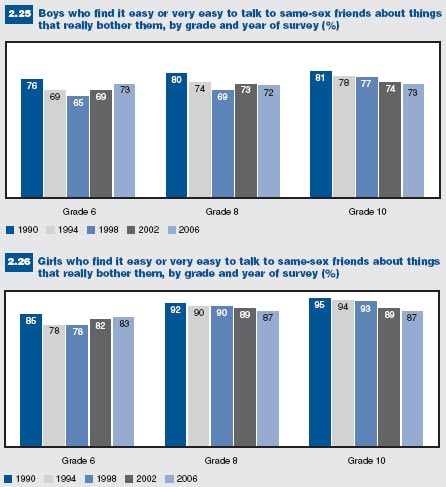Common menu bar links
Institutional links
Diseases & Conditions
Health & Safety
Research & Statistics
Agency Information
Search Box
Healthy settings for young people in Canada
Previous | Table of Contents | Next
Peers
by Hana Saab
The importance of friends
 Relationships with peers of the same or opposite sex are essential to the healthy
psychological and social development of children and adolescents and for fostering their
self-esteem and sense of well-being. The skills gained through these friendships are also
essential to the development of romantic relationships.
Relationships with peers of the same or opposite sex are essential to the healthy
psychological and social development of children and adolescents and for fostering their
self-esteem and sense of well-being. The skills gained through these friendships are also
essential to the development of romantic relationships.
Young people generally develop friendships based on interests and activities they have in common. School-aged children in particular share quite a range of behavioural patterns across two main areas. The first is school-related, and includes attitudes towards school, academic achievement, and future aspirations. The second area reflects behaviours such as smoking, drinking, substance use, dating patterns, and sexual activity as well as general anti-social or pro-social behaviours.
How is the peer context measured by the HBSC survey?
The HBSC survey gathered information on the peer context by asking students a series of questions about the number of friendships they had with both genders, about spending time with friends, and about the extent to which they were close to their friends in a way that allowed them to share matters of concern. In addition, three questions from the HBSC survey asked students to estimate the proportion of their friends, from none to all, who liked school, thought getting good marks was important, and got along with their parents.
What are we reporting on in this section?
| For data on the impact of the larger peer group on the school experience, see Figure 2.19 earlier in this chapter. |
In this section, we indicate the percentage of students with three or more same-sex friendships and trend data on students’ ease of communication with these individuals. Similar information on opposite-sex friends is provided. We also report on ease of communication with best friends. Data on time spent with friends after school and in the evenings and the percentage of young people who communicate with their friends by phone, text message, and email are reported. Finally, friends’ attitudes towards school and school achievement and their relationships with their parents are discussed, as are the communication with friends and pro-social attitudes of friends scales that are used in subsequent chapters of the report.
Same-sex friends
 Having friends and being able to share concerns
with them is regarded as a safeguard
or buffer against negative life experiences.
The number of boys who report having
three or more same-sex friends remains fairly
consistent across grades, with
slight decreases in Grades 8 and 10
(Figure 2.23). The pattern for girls who
report having three or more close same-sex
friends is also consistent until Grade 8,
after which there is a decrease from 91%
in Grade 8 to 82% in Grade 10.
Having friends and being able to share concerns
with them is regarded as a safeguard
or buffer against negative life experiences.
The number of boys who report having
three or more same-sex friends remains fairly
consistent across grades, with
slight decreases in Grades 8 and 10
(Figure 2.23). The pattern for girls who
report having three or more close same-sex
friends is also consistent until Grade 8,
after which there is a decrease from 91%
in Grade 8 to 82% in Grade 10.
Girls, however, remain more comfortable than boys talking to same-sex friends about things that really bother them, with a slight increase in the proportion of girls confiding in their same-sex friends from 83% in Grade 6 to 87% in Grade 10 (Figure 2.24). The pattern for boys remains consistent across the grades, with over 70% of boys reporting that they talk to their same-sex friends about things that really bother them.
When examined by year of survey (Figures 2.25 and 2.26), a decrease is seen after the year 1990 in the proportion of students, both boys and girls and particularly in Grade 10, who find it easy to talk to their same-sex friends about things that really bother them.

